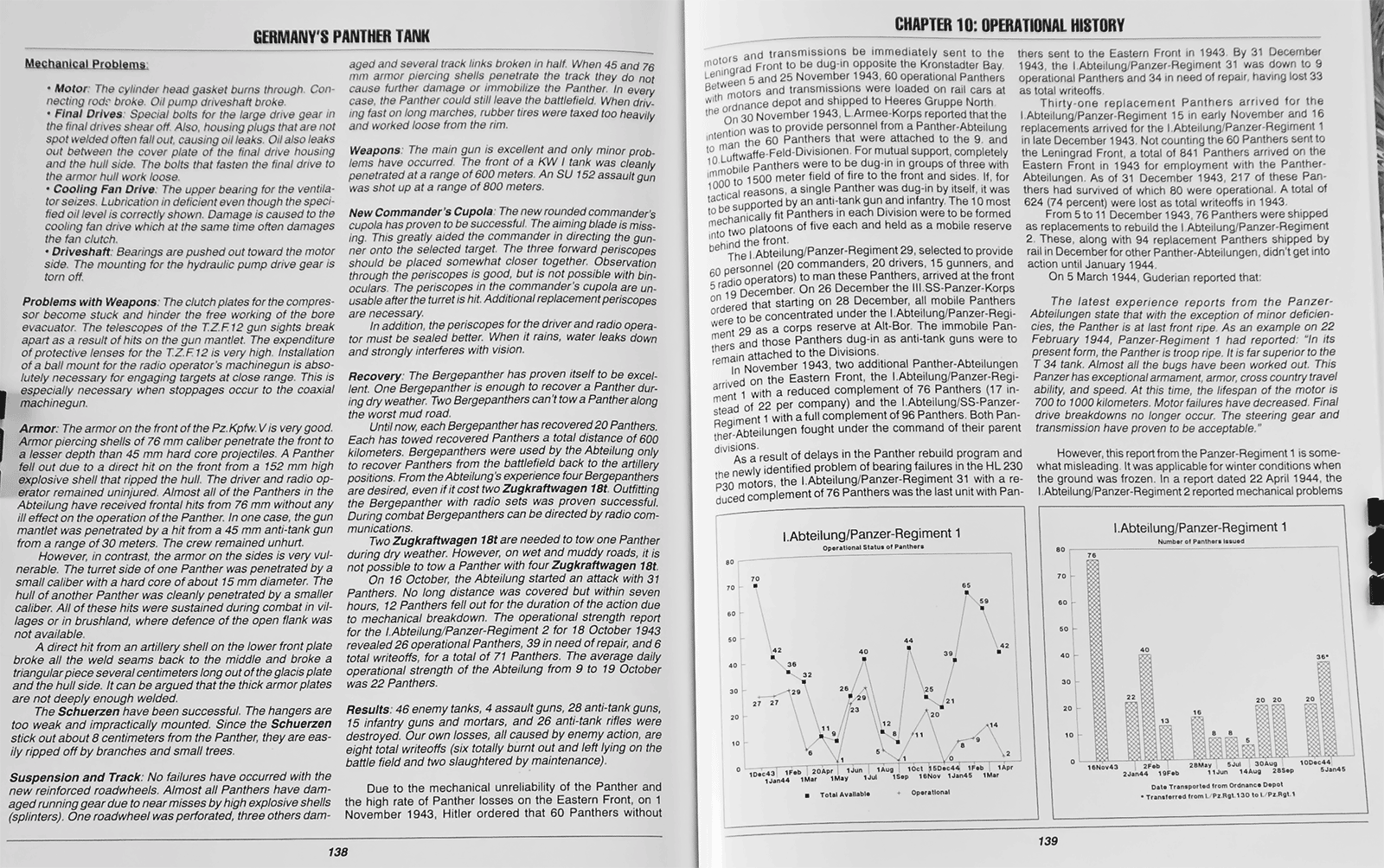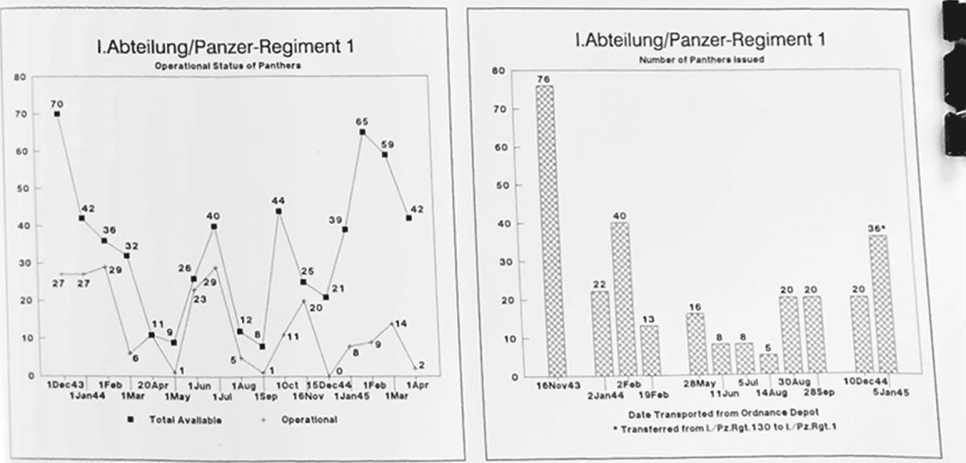071

GERMAIMY S PANTHER TANK
Mechanical Problem#
• Motor The cylinder head gasket burns through Con-necting rodu' broke Oil pump dnveshatt broke
• Finał Dr i v es Special bolts for the large dnve gear m the finał drives shear off Also, housing plugs that are not spot welded often fali out. causmg oil leaks Oilalsoleaks out between the cover piąte of the finał drive housing and the hull side. The bolts that fasten the finał dnve to the armor hull work loose
• Cooling Fan Drive The upper beanng for the ventila-tor seizes. Lubrication m deficient even though the speci-fied oil level is correctly shown. Damage is caused to the cooling fan drive which at the same time often damages the fan clutch.
• Driveshaft: Bearmgs are pushed out toward the motor side. The mounting for the hydraulic pump drive gear is tom off.
Problems with Weapons The clutch plates for the compres-sor become stuck and hinder the free workmg of the borę evacuator. The telescopes of the T.Z.F. 12 gun sights break apart as a result ofhits on the gun mantlet. The expenditure of protective lenses for the T.Z.F. 12 is very high Installation of a bali mount for the radio operator s machmegun is abso-lutely necessary for engaging targets at close rangę. This is
Iespecially necessary when stoppages occur to the coaxial machinegun.
I Armor: The armor on the front of the Pz. Kpfw. V is very good. Armor piercing shells of 76 mm caliber penetrate the front to a lesser depth than 45 mm hard core projectiles A Panther fell out due to a direct hit on the front from a 152 mm high exp!osive Shell that ripped the hull. The driver and radio operator remained uninjured. Almost all of the Panthers in the Abteilung have received frontal hits from 76 mm without any ill effect on the operation of the Panther. In one case. the gun mantlet was penetrated by a hit from a 45 mm anti-tank gun from a rangę of 30 meters. The crew remained unhurt.
However. in contrast. the armor on the sides is very vul-nerable. The turret side of one Panther was penetrated by a smali caliber with a hard core ofabout 15 mm diameter. The hull ofanother Panther was cleanly penetrated by a smaller caliber. All of these hits were sustamed during combat in vil-lages or in brushland, where defence of the open flank was not availabie.
A direct hit from an artillery Shell on the lower front piąte broke all the weld seams back to the middle and broke a tnangular piece several centimeters long out ofthe glacis piąte and the hull side. It can be argued that the thick armor plates are not deeply enough welded.
The Schuerzen have been successful. The hangers are too weak and impractically mounted. Since the Schuerzen stick out about 8 centimeters from the Panther, they are eas-ily ripped off by branches and smali trees.
Suspens!on and Track: No failures have occur red with the new reinforced roadwheels. Almost all Panthers have dam-aged running gear due to near misses by high explosive shells (splinters). One roadwheel was perforated, three others dam-aged and several track links broken in half When 45 and 76 mm armor piercing shells penetrate the track they do not causa turther damage or immobihze the Panther In every case. the Panther could still leave the battlefield. When driv-mg fast on long marches. rubber tires were taxed too heavily and worked loose from the rim.
Weapons The main gun is excellent and only minor prób-lems have occur red The front of a KWI tank was cleanly penetrated at a rangę of 600 meters. An SU 152 assault gun was shot up at a rangę of 800 meters.
New Commander ’s Cupola The new rounded commander s cupola has proven to be successful The aiming blade is miss-mg. This greatly aided the commander in directmg the gun-ner onto the selected target The three forward periscopes should be placed somewhat closer together. Observation through the periscopes is good. but is not possible with bin-oculars The periscopes in the commander's cupola are un-usable after the turret is hit. Additional replacement periscopes are necessary.
In addition. the periscopes for the driver and radio operator must be sealed better. When it rains, water leaks down and strongly mterferes with vision.
Recovery The Bergepanther has proven itself to be excel-lent. One Bergepanther is enough to recover a Panther during dry weather. Two Bergepanthers can't tow a Panther along the worst mud road.
Until now, each Bergepanther has recovered 20 Panthers. Each has towed recovered Panthers a total distance of 600 kilometers. Bergepanthers were used by the Abteilung only to recover Panthers from the battlefield back to the artillery positions. From the Abteilung's experience four Bergepanthers aredesired. even ifitcost two Zugkraftwagen 18t Outfitting the Bergepanther with radio sets was proven successful. During combat Bergepanthers can be directed by radio Communications.
Two Zugkraftwagen 18t are needed to tow one Panther during dry weather. However, on wet and muddy roads, it is not possible to tow a Panther with four Zugkraftwagen 18t
On 16 October. the Abteilung started an attack with 31 Panthers. No long distance was covered but within seven hours, 12 Panthers fell out for the duration of the action due to mechanical breakdown. The operational strength report for the I.Abteilung/Panzer-Regiment 2 for 18 October 1943 revealed 26 operational Panthers, 39 in need ofrepair, and 6 total writeoffs, for a total of 71 Panthers. The average daily operational strength of the Abteilung from 9 to 19 October was 22 Panthers.
Results 46 enemy tanks, 4 assault guns, 28 anti-tank guns, 15 infantry guns and mortars, and 26 anti-tank rifles were destroyed. Our own losses. all caused by enemy action, are eight total writeoffs (six totally burnt out and left lying on the battle field and two slaughtered by maintenance).
Due to the mechanical unreliability of the Panther and the high ratę of Panther losses on the Eastern Front, on 1 November 1943, Hitler ordered that 60 Panthers without
CHAPTER10: OPERATIONAL HI8T0RY
thers sent to the Eastern Front m 1943 By 31 December 1943, the I Abteilung/Panzer-Regiment 31 was down to 9 operational Panthers and 34 in need of repair havmg lost 33 as total writeoffs
Thirty-one replacement Panthers arrived for the l Abteilung/Panzer-Regiment 15 in early November and 16 replacements arrived for the I Abteilung/Panzer-Regiment 1 in late December 1943 Not counting the 60 Panthers sent to the Leningrad Front, a total of 841 Panthers arnved on the Eastern Front m 1943 for employment with the Panther-Abteilungen. As of 31 December 1943, 217 of these Panthers had survived of which 80 were operational A total of 624 (74 percent) were lost as total writeoffs m 1943
From 5 to 11 December 1943. 76 Panthers were shipped as replacements to rebuild the I Abteilung/Panzer-Regiment 2 These. along with 94 replacement Panthers shipped by raił in December for olher Panther-Abteilungen. didnt get mto action until January 1944
On 5 March 1944. Guderian reported that:
The latest experience reports from the Panzer-Abteilungen State that with the exception of minor deficien-cies. the Panther is at last front ripe As an exampte on 22 February 1944, Panzer-Regiment 1 had reported. “In its present form, the Panther is troop npe It is far superior to the T 34 tank. Almost all the bugs have been worked out. This Panzer has exceptional armament, armor, cross country travel abihty, and speed. At this time, the lifespan of the motor is 700 to 1000 kilometers. Motor failures have decreased Finał dri\/e breakdowns no longer occur. The steermg gear and transmission have proven to be acceptable "
As a result of delays in the Panther rebuild program and However. this report from the Panzer-Regiment 1 is some-the newly identified problem of bearing failures in the HL 230 what misleading It was applicable for winter conditions when P30 motors. the I.Abteilung/Panzer-Regiment 31 with a re- the ground was frozen. In a report dated 22 April 1944. the duced complement of 76 Panthers was the last unit with Pan- I Abteilung/Panzer-Regiment 2 reported mechanical problems

motors and transmissions be immediately sent to the Leningrad Front to be dug-in opposite the Kronstadter Bay Between 5 and 25 November 1943.60 operational Panthers *ith motors and transmissions were loaded on raił cars at the ordnance depot and shipped to Heeres Gruppe North
On 30 November 1943, L Armee-Korps reported that the mtention was to provide personnel from a Panther-Abteilung to man the 60 Panthers that were attached to the 9 and 10 Luftwaffe-Feld-Divisionen For mutual support. completely immobile Panthers were to be dug-in in groups of three with 1000 to 1500 meter field of fire to the front and sides If. for tactical reasons. a single Panther was dug-in by itself. it was to be supported by an anti-tank gun and mfantry The 10 most mechamcally fit Panthers m each Division were to be formed mto two platoons of five each and held as a mobile reserve behind the front.
The I Abteilung/Panzer-Regiment 29. selected to provide 60 personnel (20 commanders. 20 drivers. 15 gunners. and 5 radio operators) to man these Panthers. arrived at the front on 19 December On 26 December the III SS-Panzer-Korps ordered that startmg on 28 December, all mobile Panthers were to be concentrated under the I Abteilung/Panzer-Regi-ment 29 as a corps reserve at Alt-Bor The immobile Panthers and those Panthers dug-in as anti-tank guns were to remain attached to the Divisions
In November 1943, two additional Panther-Abteilungen arrived on the Eastern Front, the I.Abteilung/Panzer-Regi-ment 1 with a reduced complement of 76 Panthers (17 m-stead of 22 per company) and the I.Abteilung/SS-Panzer-Regiment 1 with a fuli complement of 96 Panthers. Both Pan-tner-Abteilungen fought under the command of their parent divisions.
139
Wyszukiwarka
Podobne podstrony:
GERMAIMV S PANTHER TANK The VK 20.01 (K). designed by Krupp for a maximum speed of 56 km/hr, had a l
GERMAIMY S PANTHER TANK 6) in Berlin on 28 and 29 January 1942 and recorded the results of the discu
GERMAI1Y‘S PANTHER TANK Acutaway view showmg the internal layout drawn from one of two Ausf.G Panthe
GERMAIMY S PANTHER TANK "Sgt Ameth Anderson, Tank Commander “In our tanks we have not the ar mo
6ERMAIMY S PANTHER TANK Interior views ot the turrei platform for the Versuchs-Turm mounted on Versu
GERMANYS PANTHER TANK caused by dnvmg m the deep. heavy mud encountered m the Spring The fol Iow mg
GERMANYS PANTHER TANK must break Also. the enemy is awakened and sent his artil-tery and mortar shel
33978 Suzuki RM125? 6-12 CYLINDER, PISTON AND EXHAU$T VALVE • Tighten the cylinder head nuts to the
40104 page6 (21) Special sfuds now used for securing the rockcr arm shaft ło the cylinder head ensur
GERMAN Y S PANTHEH TANK was almost completed. A model of the motor was complete and was to be sent t
GERMAIIV S PANTHER TANK Startmg in Apm 1943 Schuerzen (soft Steel skirts) were mounted wilh brackets
GERMANYS PANTHER TANK The weapons functioned tree ot problems The Panther otten succeeded m killmg T
GERMANY S PANTHER TANK The spent MG cartndge tubę pulled out when the n s depressed When the gun was
GERMANY S PANTHER TANK I Befehls-Panther Ausf D. Tactical Nr 155. possessed the last changes madę to
GERMANY S PANTHER TANK 4 3.11 CREW COMPARTMENT HEATER AND ENGINE Durmg cold weather. the Kampfraumhe
więcej podobnych podstron